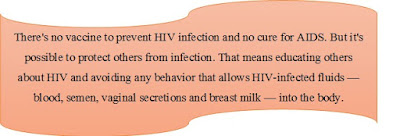HIV Prevention

What Young People Need to Know? The behavior of young people now will determine the future of the HIV and AIDS epidemic. If we cannot change the behavior of people who do not have HIV and AIDS, the disease will only spread even more widely. There are many different kinds of projects that can be used to reach young people. The most successful ones all over the world, have used the principle of “peer education”. This means that young people are trained to be the educators of other young people. They are much better at communicating with other young people and are not treated with the suspicion that young people might have for older people who come and tell them what to do with their lives. Young people need to be educated and learn how to deal with things like: Preventing HIV and AIDS through healthy and safe sexual practices Preventing sexually-transmitted infections Understanding drug-use and the spread of HIV and AIDS Understanding sex, reproduction and safe-sex ...
